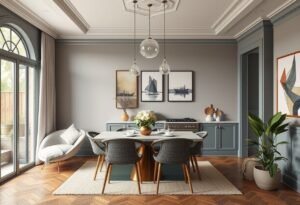The Essence of General Lighting
The first step in crafting an effective lighting design is choosing the right general lighting. This serves as the primary source of illumination, providing an even distribution across the entire room. For smaller areas, investing in ceiling-mounted fixtures or adjustable flush mounts can make all the difference. Such solutions not only brighten the room but also create a cozy atmosphere where one can unwind after a long day.
Spotlighting for Impact
Small spaces require careful attention to spotlighting. Elements that are not just light sources but also highlight significant features are crucial in creating a holistic space. Consider incorporating table lamps, wall sconces, or hanging fixtures over dining areas; these direct sources of light can illuminate specific corners and elevate the overall design. It’s a wonderful way to draw attention to cherished decorations or your favorite reading nook.
Color and Materials Matter
The colors of the walls and the materials used for your lighting fixtures are vital in shaping the perception of space. Light colors can make rooms appear larger, while shiny finishes reflect light, enhancing the feeling of openness. Thus, opting for lamps in bright hues or with reflective surfaces can bring a fresh, airy feel to your environment, making it a pleasure to come home to.
Create Layers of Light
In smaller rooms, it’s essential to adopt a *layered* approach to lighting. This method involves blending various lighting types—general, accent, and task lighting. By diversifying your lighting sources, you create harmony within the space, making it suitable for both work and relaxation. Imagine transitioning seamlessly between the glow of a reading lamp in the evening to a bright overhead light during the day.
Functionality Comes First
Particularly in compact areas, functionality becomes paramount. Utilizing LED fixtures can not only save energy but also provide bright, efficient lighting. You might also consider adjustable lamps, which allow you to modify both the direction and intensity of light as needed, making it easy to adapt your environment to suit everything from focused reading sessions to cozy movie nights.
Lighting as a Decorative Element
Another important aspect is treating lighting as a decorative feature. In small spaces, your fixtures can act as statement pieces that draw the eye. Choosing stylish wall lamps or unique table fixtures not only serves the functionality purpose but can also enhance the room’s overall aesthetic. Select pieces that resonate with your personal style, creating a warm and inviting home that reflects who you are.
Conclusion
In conclusion, appropriate lighting has a tremendous effect on the perception of small spaces. It is crucial to aim for a balanced combination of general, accent, and decorative lighting. Pay attention to layering, functionality, and the use of light colors and reflective materials. With these tips, you can create an environment that is not only visually spacious but also rich in warmth and comfort. Transform your interiors with thoughtful lighting choices, and discover how it can elevate your daily life into something extraordinary.
Disclaimer
This article is for informational purposes only and does not substitute for professional advice in the field of lighting. Before making any changes, it is advisable to consult with a specialist to select the best solutions for your space.

















